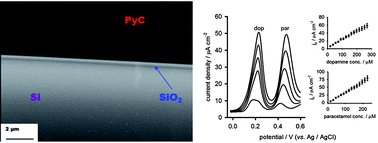Simultaneous electrochemical determination of dopamine and paracetamol based on thin pyrolytic carbon films
Abstract
This paper describes the determination of

* Corresponding authors
a
Département de Chimie Moléculaire, UMR 5250, ICMG FR 2607, CNRS, Université Joseph Fourier, BP 53, 38041, Grenoble cedex 9, France
E-mail:
gkeeley@ujf-grenoble.fr
Fax: + 33 4 5652 0805
Tel: + 33 4 5652 0853
b Centre for Research on Adaptive Nanostructures and Nanodevices (CRANN), Trinity College, Dublin 2, Ireland
c School of Chemistry, Trinity College, Dublin 2, Ireland
This paper describes the determination of

 Please wait while we load your content...
Something went wrong. Try again?
Please wait while we load your content...
Something went wrong. Try again?
G. P. Keeley, N. McEvoy, H. Nolan, S. Kumar, E. Rezvani, M. Holzinger, S. Cosnier and G. S. Duesberg, Anal. Methods, 2012, 4, 2048 DOI: 10.1039/C2AY25156F
To request permission to reproduce material from this article, please go to the Copyright Clearance Center request page.
If you are an author contributing to an RSC publication, you do not need to request permission provided correct acknowledgement is given.
If you are the author of this article, you do not need to request permission to reproduce figures and diagrams provided correct acknowledgement is given. If you want to reproduce the whole article in a third-party publication (excluding your thesis/dissertation for which permission is not required) please go to the Copyright Clearance Center request page.
Read more about how to correctly acknowledge RSC content.
 Fetching data from CrossRef.
Fetching data from CrossRef.
This may take some time to load.
Loading related content
